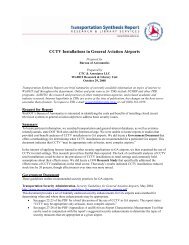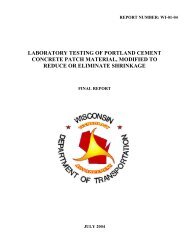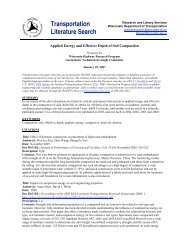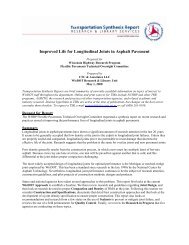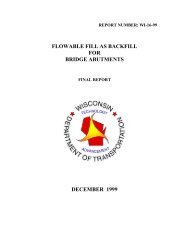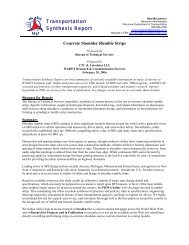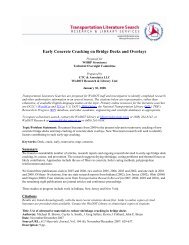Lateral Spreading of Soft Soils - WisDOT Research
Lateral Spreading of Soft Soils - WisDOT Research
Lateral Spreading of Soft Soils - WisDOT Research
Create successful ePaper yourself
Turn your PDF publications into a flip-book with our unique Google optimized e-Paper software.
Title: A Framework for 3D Nonlinear Ground-Foundation Analysis<br />
Author(s): Lu, Jinchi; Elgamal, Ahmed; Shantz, Thomas<br />
Year: 2009<br />
Source/URL: 2009 GeoHunan International Conference, pages 189-196; http://tris.trb.org/view.aspx?id=900844<br />
Description: 8 pages<br />
Contents: Three-dimensional nonlinear finite element simulations are becoming increasingly feasible for<br />
transportation geotechnical applications. This paper presents a robust and versatile framework that helps streamline<br />
the use <strong>of</strong> finite elements for seismic response <strong>of</strong> soil-structure systems. In this regard, a Windows-based graphicaluser-interface<br />
OpenSeesPL is developed for pile-ground interaction analysis. Particularly suited to seismic<br />
applications, the open-source computational platform OpenSees is employed throughout. OpenSeesPL allows<br />
convenient studies <strong>of</strong> three-dimensional seismic (earthquake) and/or push-over pile analyses. Various ground<br />
modification scenarios may be also addressed by appropriate specifications <strong>of</strong> the material within the pile zone. To<br />
illustrate the capabilities <strong>of</strong> OpenSeesPL, two studies are presented in this paper. <strong>Lateral</strong> spreading effects on pile<br />
foundations are modeled, followed by an investigation <strong>of</strong> ground remediation in a mildly sloping silt stratum. Along<br />
with the insights gained from these studies, the reported effort aims to highlight the analysis framework capabilities<br />
and range <strong>of</strong> potential applications.<br />
Title: Geogrid-Reinforced Roadway Embankment on S<strong>of</strong>t <strong>Soils</strong>: A Case Study<br />
Author(s): Vega-Meyer, Reinaldo; Garrido, Roberto Sosa; Piedrabuena, Alberto Ramírez; Larios, Ignacio Narezo;<br />
Lapuente, Ramón Pico<br />
Year: 2007<br />
Source/URL: S<strong>of</strong>t Soil Engineering: Proceedings <strong>of</strong> the Fourth International Conference on S<strong>of</strong>t Soil Engineering,<br />
pages 129-138; http://www.crcnetbase.com/doi/abs/10.1201/9781439833926.pt2<br />
Description: 10 pages<br />
Contents: Building earth structures on s<strong>of</strong>t soils is one <strong>of</strong> the toughest challenges in civil engineering. Due to the fill<br />
embankment and surcharges, the settlements associated to the overburden pressures are one <strong>of</strong> the major concerns in<br />
roadway embankment construction. Several methods <strong>of</strong> support improvement have been in practice for years (e.g.<br />
excavation/fill replacement, stone filling, Corduroy, etc.), but recently, geosynthetic reinforcement has been<br />
successfully incorporated as an efficient way to improve the weak soil conditions. This paper focuses on a case<br />
study that introduces a geogrid-reinforced roadway embankment located in the Texcoco Lake, near Mexico City,<br />
Mexico. The structure consists <strong>of</strong> an embankment with variable heights to be built in two different conditions: dry<br />
and saturated. The most critical section was in the saturated zone (lake) where the maximum embankment height<br />
was 2.80m and the water level was at 1.80 m, leaving only 1.0m <strong>of</strong> dry embankment body. The embankment was<br />
built on highly compressible saturated clay layers up to 40.0m deep, and moisture <strong>of</strong> up to 300%. The paper presents<br />
project design information, settlement observations, and performance evaluation. The performance <strong>of</strong> the<br />
embankment was observed during and after construction using inclinometers, and deep and surface surveying<br />
equipment. A presentation <strong>of</strong> this performance and results about the predicted vs. actual embankment settlements are<br />
included in the paper.<br />
Title: Characteristics and Engineering Properties <strong>of</strong> the S<strong>of</strong>t Soil Layer in Highway Soil Subgrades<br />
Author(s): Hopkins, Tommy C.; Beckham, Tony L.; Sun, Liecheng<br />
Year: 2006<br />
Source/URL: Kentucky Transportation Cabinet final report;<br />
http://www.ktc.uky.edu/Reports/KTC_06_13_SPR_270_03_1F.pdf<br />
Description: 101 pages<br />
Contents: The objective <strong>of</strong> this research was to examine the conditions and characteristics <strong>of</strong> soil subgrades that had<br />
been stabilized using mechanical compaction. Goals <strong>of</strong> the study are to identify and examine the engineering<br />
properties and behavior <strong>of</strong> the “s<strong>of</strong>t layer’ <strong>of</strong> material observed at the top <strong>of</strong> untreated, highway pavement soil<br />
subgrades. Alternative methods <strong>of</strong> preventing, or mitigating, the development <strong>of</strong> the s<strong>of</strong>t layer are discussed.<br />
Evidence is presented that shows that a s<strong>of</strong>t layer <strong>of</strong> soil frequently develops at the top <strong>of</strong> untreated, highway soil<br />
subgrades. Data are presented that show strengths obtained from mechanical compaction are largely destroyed when<br />
untreated compacted soils are exposed to moisture. California Bearing Ratio (CBR) values <strong>of</strong> compacted clayey<br />
soils initially are high but become small when exposed to saturation. In situ CBR values measured at the tops <strong>of</strong><br />
untreated subgrades, where mechanical compaction was the only means used to stabilize the soil subgrade, were<br />
smaller than unsoaked and soaked laboratory Kentucky CBR values. At the 85th percentile test value, the laboratory<br />
KYCBR value <strong>of</strong> compacted, unsoaked clayey specimens was 11.5 while the CBR value <strong>of</strong> soaked specimens was<br />
3.0. For comparison, the in situ CBR value <strong>of</strong> untreated subgrades at the 85th percentile test value, as shown in this<br />
study, was only 2. Using a bearing capacity model, based on limit equilibrium <strong>of</strong> layered media, bearing capacity<br />
2



